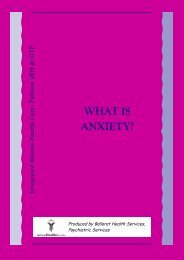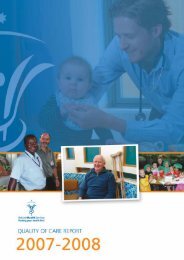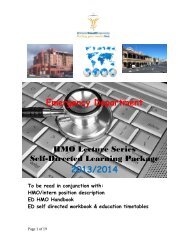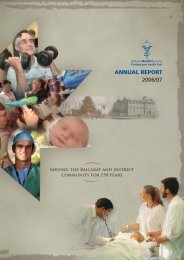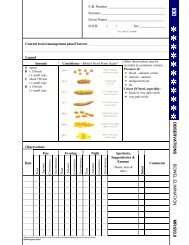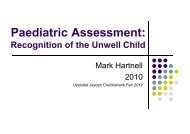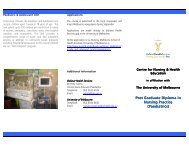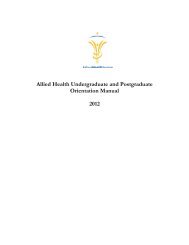Mental State Examination - BHS Education Resource
Mental State Examination - BHS Education Resource
Mental State Examination - BHS Education Resource
Create successful ePaper yourself
Turn your PDF publications into a flip-book with our unique Google optimized e-Paper software.
<strong>Mental</strong> <strong>State</strong> <strong>Examination</strong>• Appearance and Behaviour• Speech• Mood/affect• Thought• Perception• Cognition• Insight/judgement
Appearance and Behaviour•Dress•Personal hygiene•Nutritional state•Eye contact•Ease of rapport•Tattoos,piercings,•Agitation, co-operationoperation•Abnormal movements
Speech•Volume•Rate= pressured speech, difficult to interrupt•Articulation= = poverty of•Aphonia/ perseveration / echolalia / neologisms
Mood/Affect•Elevated,euthymic, , depressed, labile•Range•Blunted in schizophrenia as well asdepression
Thought Form•How the patient is thinking, the ‘grammar’•Flight of ideas mania•Rhyming, punning, clang association,•Loosening of associations schizophrenia•‘Knights move’, , derailment, word salad•Concrete thinking schizophrenia or organic
Thought content• Delusions – bizarre, non-bizarre• Grandiose, nihilistic, persecutory, of reference, religious,guilt• Thought insertion, thought withdrawal, thought broadcasting• Obsessions +/- compulsions• Phobias• Overvalued ideas• Specific antisocial urges• Suicide/homicide statements – fleeting, fixed, plans
Cognition•Orientation to TPP•STM and LTM•Mini mental•concentration
Insight/Judgement•Does the patient think they are ill•Do they think they have a mental illness•Do they think they need treatment•If so do they accept medical treatment•If they don’t t think they are ill but accept treatmentwhy do they do this• ie existence of illness and need for treatment
Psychosis1 or more of the following:-•Delusions•Hallucinations•Thought disorder of form•Bizarre behaviour
Schizophrenia• Heterogeneous group of illnesses,characterized by positive & negativesymptoms.• Positive – psychosis• Negative – poor motivation, apathy, decline insocial functioning
Schizophrenia• Schizophrenia is defined as positive > 1/12 &positive and negative > 6/12• Schizophreniform = ‘schizophrenia’ < 6/12• Bizarre delusions schizophrenia• 2 out of 4 psychotic features + negativesymptoms schizophrenia
Depression & Suicide Risk Ax• Multiple scales / checklist approach• Most useful as reminder about questions toask and issues for the non-expert• Eg.s inc the “Sad persons” scale
Depression•>3 of the following, nearly everyday for > 2 weeks•In•S•A•D•CInterest (loss of)Sleep disorderAppetite disturbanceDysphoriaConcentration•A Activity ()(•G•E•SGuiltEnergy (lack of)Suicide ideation
CharacteristicHigh RiskLow RiskSocial profileAgeSexMarital statusEmployment status●●●●> 45 yearsMaleDivorced, widowed.Unemployed●●●●< 45 yearsFemaleMarriedEmployedHealthPhysical<strong>Mental</strong>(Pre-existing psychiatric illnessprofile)●●●●●Chronic illnessSubstance/ alcohol abuseSevere depression.PsychosisPersonality disorder●●●●●Good health.No substance abuseMild depression.Neurosis.Normal personality
CharacteristicHigh RiskLow RiskEventIdeationMethodology●●●●●●●Hopelessness & guiltespecially if frequent,intense, prolonged.Unambiguous wish to die.Feelings internalised.High lethality, especially ifviolent and available, suchas a gun.Low chance of rescue.PlannedPrevious attempts.●●●●●●●Remorse, embarrassment,optimistic, bad feelingsare infrequent, transientlow intensity.Primary wish is for change.Feelings externalised.Low lethality.High change of rescue.ImpulsiveFirst attempt.
CharacteristicHigh RiskLow Risk<strong>Resource</strong>sPersonalSocial Supports●●●●●●Poor achieverPoor insightPoor rapportFlat or poorly controlledaffect.Social isolationUnresponsive family● High achiever● Good insight● Good rapport● Affect is available or “seen”and appropriately controlled● Socially integrated● Concerned family
The SAD PERSON Scale Suicide Risk Evaluation 2 2Risk FactorSexAgeDepressionPsychiatric CareExcessive Drug UseRational Thinking LossSeparated (or single)Organized AttemptNo Life Supports<strong>State</strong>s Future IntentCriteriaMale Gender< 19 years, > 45 yearsMood disturbance and somatic symptoms.Previous suicide attempts or formal psychiatrichistoryHistory of alcohol or drug abuseSevere depression or psychosis or acute brainsyndrome.Single, separated, widowed, divorced.Serious, well planned attempt or ideationSocial and interpersonal isolationDetermination to repeat the attemptPoints112112121Score > 8 Indicates High Risk“DROS” is a mnemonic for the 2 point scores.
CERTIFICATIONBy H. Crook
<strong>Mental</strong> health Act 1986Part 3 – admission of patients Division 2-involantary patients• Section 8 = criteria for admission as an involuntarypatient• Section 9 (1a) = request (schedule 1)• Section 9(1b) = recommendation (schedule 2)• Section 9 (7)= restraint & sedation (schedule 3forms 1 & 2• Section 9 (7A)= authority to transfer (schedule 4)• Section 10 = apprehension of mentally ill persons incertain circumstances• Section 12 = involuntary treatment order
INVOLUNTARY ADMISSION• Need to satisfy following criteria.• Person must appear to be mentally ill.• <strong>Mental</strong> illness must require immediate attention.• That attention cannot be given as an outpatient.• The person should be detained for the health and safety ofthemselves and/or others.• The person has refused or is unable to consent totreatment.• The person cannot receive treatment in a less restrictivemanner.
A person is not to be considered mentally ill byreasoning of the following.• Expresses or refuses to express certain political beliefs.• Expresses or refuses to express certain religiousbeliefs.• Expresses or refuses to express certain sexualorientation.• That the person engages in sexual promiscuity,immoral or illegal conduct,• That the person is intellectually disabled.• That the person takes drugs or alcohol, or is antisocial.• (This does not prevent the physiological, biochemical orpsychological effects of drug or alcohol taking frombeing regarded as an indication that a person ismentally ill.
INVOLUNTARY ADMISSION• 2 requirements.• 1. Schedule 1.• Request for admission.• May be completed by any adult, inc police, nurses,relatives.• 2. Schedule 2.• Recommendation completed by legally qualified medicalpractitioner in state of Victoria.• Must have examined patient within three days.• Cannot fill in schedule 1 also.• Patient must then be examined by authorised psychiatristwithin 24 hours to uphold (section 12)• Cannot be a relative of the patient.
INVOLUNTARY ADMISSION• Guidelines are attached to the certificates if in doubt.• Forms don’t have to be signed prior to restraint.• Once forms have been signed, can only be revoked by anapproved psychiatrist, and must be assessed within 24hours.• In an emergency pre-hospital personnel may use anemergency order to restrain the patient.• Separate forms to be filled in for transport, sedation andrestraint.• Does not prevent patient from consenting to nonpsychiatrictreatment.
Restraint Schedule 3/1• Any prescribed person can apply restraintsfor the purposes of safe transportation
PRESCRIBED PERSONS• Police• Ambulance• Doctors• Nurses• Psychologist• Social worker• Occupational therapist-only if employed by aMHS, hospital, child psychiatric service
Sedation Schedule 3/2• A prescribed registered medical practitionermay prescribe sedation for the purposes oftransportation



